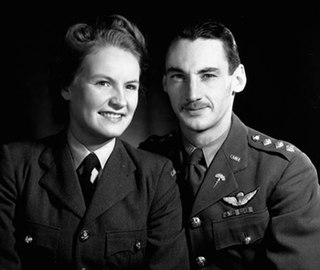
Noor-un-Nisa Inayat Khan, GC, also known as Nora Inayat-Khan and Nora Baker, was a British resistance agent in France in the Second World War who served in the Special Operations Executive (SOE). The purpose of SOE was to conduct espionage, sabotage, and reconnaissance in countries occupied by the Axis powers, especially those occupied by Nazi Germany.

The Women's Auxiliary Air Force (WAAF), whose members were referred to as WAAFs, was the female auxiliary of the British Royal Air Force during the Second World War. Established in 1939, WAAF numbers exceeded 181,000 at its peak strength in 1943, with over 2,000 women enlisting per week.

Eileen Mary "Didi" Nearne MBE, Croix de Guerre was a member of the UK's Special Operations Executive (SOE) in France during World War II. The purpose of SOE was to conduct espionage, sabotage, and reconnaissance in countries occupied by Nazi Germany and other Axis powers. SOE agents allied themselves with resistance groups and supplied them with weapons and equipment parachuted in from England.

RAF Rudloe Manor, formerly RAF Box, was a Royal Air Force station north-east of Bath, England, between the settlements of Box and Corsham, in Wiltshire. It was one of several military installations in the area and covered three dispersed sites. Parts of the site are now used by Defence Digital within the MoD Corsham complex; other areas are vacant and some have been sold, including the 17th-century manor house, Rudloe Manor.
Younghusband may refer to:

Air Commandant Dame Felicity Hyde, Lady Peake was the founding director of the Women's Royal Air Force (WRAF) She started flying when her first husband took up the hobby in 1935, but in 1946 became the first director of the WRAF. She was Honorary Aide-de-camp to King George VI from 1949 to 1950.
Joan Olivia Wyndham was a British writer and memoirist who rose to literary prominence late in life through the diaries she had kept more than 40 years earlier, which were an account of her romantic adventures during the Second World War, when she was an attractive teenager who had strayed into London's Bohemian set. Her literary reputation rests on Love Lessons (1985) and Love Is Blue (1986), two selections from her diaries which led one critic to call her "a latterday Pepys in camiknickers."

Joan Daphne Mary Pearson, was a Women's Auxiliary Air Force officer during the Second World War and one of only thirteen female recipients of the George Cross, the highest decoration for gallantry not in the face of an enemy that can, or could, be awarded to a citizen of the United Kingdom or the Commonwealth.

Royal Air Force Barton Hall or more simply RAF Barton Hall is a former Royal Air Force station situated between the villages of Barton and Broughton, near Preston, Lancashire, England.

Sonya Esmée Florence Butt, also known as Sonia d'Artois, code named Blanche, was an agent of the clandestine Special Operations Executive during the Second World War. SOE agents allied themselves with groups resisting the occupation of their countries by Axis powers. The purpose of SOE was to conduct espionage, sabotage, and reconnaissance in occupied countries. The SOE supplied resistance groups with weapons and equipment parachuted in from England.

Clare Grant Stevenson, AM, MBE was the inaugural Director of the Women's Auxiliary Australian Air Force (WAAAF), from May 1941 to March 1946. As such, she was described in 2001 as "the most significant woman in the history of the Air Force". Formed as a branch of the Royal Australian Air Force (RAAF) in March 1941, the WAAAF was the first and largest uniformed women's service in Australia during World War II, numbering more than 18,000 members by late 1944 and making up over thirty per cent of RAAF ground staff.

Mary Teston Luis Bell was an Australian aviator and founding leader of the Women's Air Training Corps (WATC), a volunteer organisation that provided support to the Royal Australian Air Force (RAAF) during World War II. She later helped establish the Women's Auxiliary Australian Air Force (WAAAF), the country's first and largest women's wartime service, which grew to more than 18,000 members by 1944.
Beryl E. Escott is a Canadian-born writer specializing in the history of the Women's Auxiliary Air Force. A native of Newfoundland, Escott was educated in Wales and England. She served in the Royal Air Force from 1961 to 1986.
Constance Babington Smith MBE, FRSL was a British journalist and writer, but is probably best known for her wartime work in imagery intelligence.

A Filter Room was part of RAF Fighter Command's radar defence system in Britain during the Second World War. The filter room at Fighter Command Headquarters lay at the top of the Dowding system - the integrated ground-controlled interception network that covered the United Kingdom. The operations were considered secret and, as such, were covered by the Official Secrets Act.

Nathan Wyburn is a contemporary Welsh artist and media personality who has created celebrity portraits (iconography) and pop culture imagery using non-traditional media such as foodstuffs and other household items, including most notably working with Marmite on toast.
Air Commodore Dame Felicity Barbara Hill, was a British Royal Air Force officer. From 1966 to 1969, she served as Director of the Women's Royal Air Force. She died in January 2019 at the age of 103.
Air Commandant Dame Mary Henrietta Barnett was a senior officer of the Women's Royal Air Force (WRAF). From 1956 to 1960, she served as its director.
Air Commandant Dame Anne Stephens was Director of the British Women's Royal Air Force from 1960 until her retirement in 1963. She was awarded an MBE in 1946, and elevated to DBE in 1961.

Elspeth Candlish Green was an NCO and officer in the Women's Auxiliary Air Force (WAAF). She was a plotter during the Battle of Britain, serving at Biggin Hill where she won the Military Medal for her bravery during repeated air raids.












